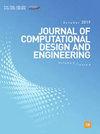Improved semantic segmentation network using normal vector guidance for LiDAR point clouds
IF 6.1
2区 工程技术
Q1 COMPUTER SCIENCE, INTERDISCIPLINARY APPLICATIONS
引用次数: 0
Abstract
Abstract As LiDAR sensors become increasingly prevalent in the field of autonomous driving, the need for accurate semantic segmentation of 3D points grows accordingly. To address this challenge, we propose a novel network model that enhances segmentation performance by utilizing normal vector information. Firstly, we present a method to improve the accuracy of normal estimation by using the intensity and reflection angles of the light emitted from the LiDAR sensor. Secondly, we introduce a novel local feature aggregation module that integrates normal vector information into the network to improve the performance of local feature extraction. The normal information is closely related to the local structure of the shape of an object, which helps the network to associate unique features with corresponding objects. We propose four different structures for local feature aggregation, evaluate them, and choose the one that shows the best performance. Experiments using the SemanticKITTI dataset demonstrate that the proposed architecture outperforms both the baseline model, RandLA-Net, and other existing methods, achieving mean Intersection over Union (mIoU) of 57.9%. Furthermore, it shows highly competitive performance compared to RandLA-Net for small and dynamic objects in a real road environment. For example, it yielded 95.2% for cars, 47.4% for bicycles, 41.0% for motorcycles, 57.4% for bicycles, and 53.2% for pedestrians.改进的激光雷达点云法向量引导语义分割网络
随着激光雷达传感器在自动驾驶领域的日益普及,对三维点的准确语义分割的需求也随之增长。为了解决这一挑战,我们提出了一种新的网络模型,通过利用法向量信息来提高分割性能。首先,我们提出了一种利用激光雷达传感器发射光的强度和反射角来提高法向估计精度的方法。其次,我们引入了一种新的局部特征聚合模块,将法向量信息集成到网络中,以提高局部特征提取的性能。正常信息与物体形状的局部结构密切相关,这有助于网络将独特的特征与相应的物体联系起来。我们提出了四种不同的局部特征聚合结构,对它们进行了评估,并选择了表现出最佳性能的结构。使用SemanticKITTI数据集进行的实验表明,所提出的架构优于基线模型、RandLA-Net和其他现有方法,实现了57.9%的平均交联(mIoU)。此外,在真实道路环境中,与RandLA-Net相比,它在小型和动态物体上表现出了极具竞争力的性能。例如,汽车的收益率为95.2%,自行车为47.4%,摩托车为41.0%,自行车为57.4%,行人为53.2%。
本文章由计算机程序翻译,如有差异,请以英文原文为准。
求助全文
约1分钟内获得全文
求助全文
来源期刊

Journal of Computational Design and Engineering
Computer Science-Human-Computer Interaction
CiteScore
7.70
自引率
20.40%
发文量
125
期刊介绍:
Journal of Computational Design and Engineering is an international journal that aims to provide academia and industry with a venue for rapid publication of research papers reporting innovative computational methods and applications to achieve a major breakthrough, practical improvements, and bold new research directions within a wide range of design and engineering:
• Theory and its progress in computational advancement for design and engineering
• Development of computational framework to support large scale design and engineering
• Interaction issues among human, designed artifacts, and systems
• Knowledge-intensive technologies for intelligent and sustainable systems
• Emerging technology and convergence of technology fields presented with convincing design examples
• Educational issues for academia, practitioners, and future generation
• Proposal on new research directions as well as survey and retrospectives on mature field.
 求助内容:
求助内容: 应助结果提醒方式:
应助结果提醒方式:


